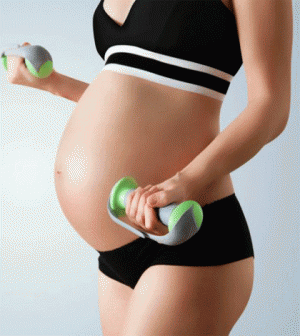- Finding Unshakable Power in a World That Wants to Pull Us ApartPosted 6 months ago
- What could a Donald Trump presidency mean for abortion rights?Posted 6 months ago
- Financial Empowerment: The Game-Changer for Women in Relationships and BeyondPosted 7 months ago
- Mental Health and Wellbeing Tips During and After PregnancyPosted 7 months ago
- Fall Renewal: Step outside your Comfort Zone & Experience Vibrant ChangePosted 7 months ago
- Women Entrepreneurs Need Support SystemsPosted 7 months ago
Training for Two: The Benefits of Training During All Stages of Pregnancy

By Michelle Goldrick
Pregnant or planning to be this year? Wondering how its going to affect your current workouts, what modifications need to be made and when? Look no further… here is some detail into how your body adjusts and the exercises change throughout your pregnancy to keep both mama and baby safe and healthy. One benefit of exercise during pregnancy is improving your physical and mental wellbeing. Maintaining a healthy weight during pregnancy helps in returning to your pre-baby weight more quickly and also reduces the risk of developing gestational diabetes, which is more common in mothers who are overweight.
There are currently no known adverse risks to a pregnant woman that are linked with meeting the recommended guidelines of at least 150 minutes of moderate-vigorous physical activity per week.
However, as pregnancy progresses, the body goes through significant changes, such as increased hormone relaxin creating looseness of joints, changes in centre of gravity and dizziness and an increased resting heart rate. Therefore, modifications to programs will undoubtedly need to be considered.
Women who are pregnant and participating in activities that require a high degree of balance or rapid changes in direction should consult with their doctor first. Your doctor may recommend that you see a physiotherapist or a Pre and Post Natal Specialist Trainer, such as myself.
While most forms of exercise are safe, there are some exercises that involve positions and movements that may be uncomfortable or harmful for pregnant women. Be guided by your doctor or physiotherapist, but general cautions include:
- Avoid raising your body temperature too high – for example, don’t soak in hot spas or exercise to the point of heavy sweating. Reduce your level of exercise on hot or humid days.
- Don’t exercise to the point of exhaustion.
- If weight training, choose low weights and medium to high repetitions – avoid lifting heavy weights altogether, unless regularly accustomed to it and/or under the supervision of a trainer for perfect form.
- Avoid exercise if you are ill or feverish.
- If you don’t feel like exercising on a particular day, don’t! It is important to listen to your body to avoid unnecessarily depleting your energy reserves.
- Don’t increase the intensity of your sporting program while you are pregnant, and always work at less than 75 per cent of your maximum heart rate.
- In addition, if you develop an illness or a complication of pregnancy, ALWAYS talk with your doctor or midwife before continuing or restarting your exercise program.
Nevertheless, as an athlete, trainer, coach, or pregnant woman, it’s also important to understand what exactly happens during pregnancy. Obviously there’s a lot more going on than an expanding waistline. Although pregnant women can usually still follow along with typical exercise programming, whether that’s weight training, running, or CrossFit, it’s still important to remember that this is a special time in a woman’s life, and training should reflect that.
Women talk a lot about the common first signs of pregnancy, morning sickness being the most infamous one. For me, one of the first tell-tale signs, even before nausea or fatigue, is unexplained breathlessness with relatively low-intensity activity and extreme dizziness. I feel winded halfway through an easy incline walk, or break out in a sweat while showing a training demonstration to a client. That’s because during pregnancy, a pregnant woman’s blood volume increases by as much as 40 percent. To deal with that increase, the heart volume must also increase by 15 to 20 percent, but that takes some time. As pregnancy goes on, you will probably be able to handle higher intensity exercise much more easily, since the body has adjusted to these changes.
If you’re used to using a heart rate monitor, you’ve probably heard that it’s not the best indicator during pregnancy.
That’s because your resting heart rate changes pretty dramatically during pregnancy, due to the increase blood volume. At this point, experts agree that Rate of Perceived Exertion is a better indicator of how hard mom is working.
Mom isn’t the only one we have to worry about here – baby is exercising too. What effect, if any, does this have on the developing baby? Will exercise stunt baby’s growth by depriving her of oxygen? A 2003 review of the medical literature concludes: “Controlled prospective studies have demonstrated that moderate prenatal exercise during the second and third trimesters is useful to improve aerobic fitness and maternal-fetal physiological reserve without affecting fetal growth.”
As a matter of fact, an active mom’s heart rate might actually line baby up for lower heart rate and increased heart rate variability.
The implications of this phenomenon are particularly important during labor and delivery. A fit baby will be more resilient during the stresses of labor. Its been discovered that during labor was the babies’ heart rate responses to the contractions of labor. There is evidence that the babies of the women who continued to exercise tolerated the stress of the contractions much better than either the controls or the women who stopped exercise well before term.
The studies on the cardiovascular effects of pregnancy continue, but so far the research is promising. In short, it seems that a tough mama makes a tough baby. So the next time you feel embarrassed at the gym huffing and puffing after two minutes of brisk walking, remember that it’s a good sign. You’re doing more work than you probably realize. Keep up the good work mama!
********
 Michelle Goldrick is a London Ontario based certified personal trainer with over 20 year’s experience in the fitness industry, with adding in some additional certification in Pre and Post Natal Specialised Personal Training. Over the years she has helped many women achieve and sustain their fitness and weight loss goals before, during and after pregnancy and into menopause. Michelle trains out of her own home based personal training studio. She also has a large online training client base. Michelle is a wife, entrepreneur and a mother to a very active 5 year old daughter.
Michelle Goldrick is a London Ontario based certified personal trainer with over 20 year’s experience in the fitness industry, with adding in some additional certification in Pre and Post Natal Specialised Personal Training. Over the years she has helped many women achieve and sustain their fitness and weight loss goals before, during and after pregnancy and into menopause. Michelle trains out of her own home based personal training studio. She also has a large online training client base. Michelle is a wife, entrepreneur and a mother to a very active 5 year old daughter.
Most recently being a breast cancer survivor, diagnosed in September 2013 with mastectomy in December 2013, she now also understand the unique obstacles to overcome physiologically and emotionally that younger women with early age diagnosis go through. Michelle can be reached at her social media accounts: IG @gfitnessmichelle TWITTER @michelleGfit www.michellegfitness.com






